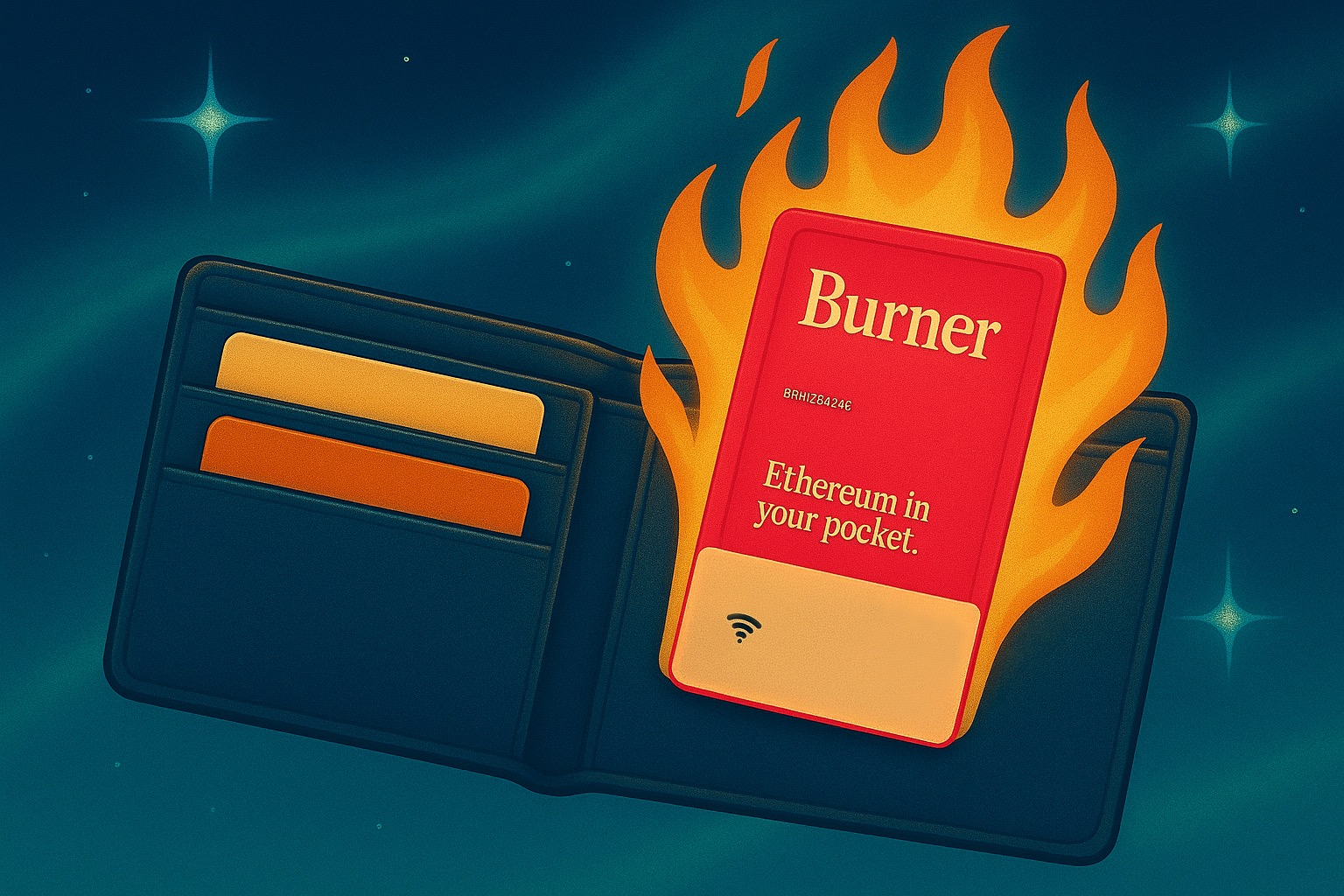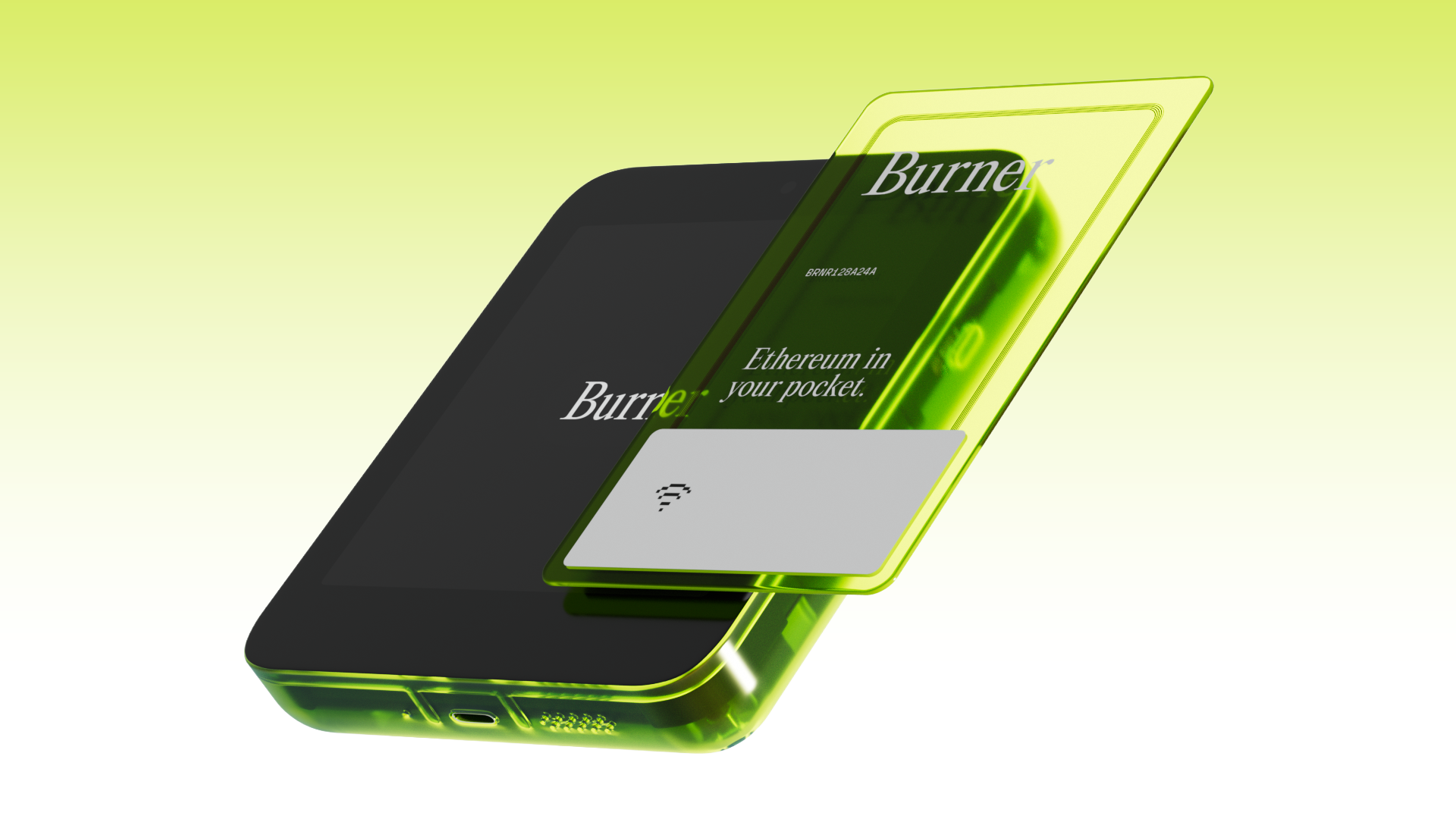What is a Burner Card? From Disposable Payments to Simple, Secure Crypto Self-Custody
Back to articles
You’ve probably come across the term “burner card” in fintech or crypto, but what it means depends on who’s using it. In one world, it refers to virtual payment cards used for safe, short-term transactions. In another, it’s shorthand for temporary crypto wallets designed for quick, low-risk use. And now, there’s a new meaning emerging: a physical hardware wallet designed for both gifting and everyday crypto use, simple to set up, easy to use, and built for secure self-custody. In this article, we’ll explore how the term has evolved across industries, and how the Burner card (with a capital B) marks its next evolution.
Burner Cards in Fintech
In traditional finance, a burner card usually refers to a temporary virtual credit or debit card used for one-time or short-term transactions. It’s a simple way to reduce risk and keep your real card details private.

These virtual cards arose from a need to combat rising online fraud, questionable websites, and unexpected subscription charges. Privacy-conscious individuals and corporate finance teams use burner cards to create safer spending habits by preventing personal information from becoming tied to online payments.
Initially created by large financial institutions for secure vendor payments, burner cards are now accessible to everyone. Various consumer credit cards now offer the ability to generate temporary virtual card numbers, and platforms like Privacy.com allow users to create numbers that deactivate after a single use or restrict them to specific merchants.
Burner Cards Wallets in Crypto
In crypto, the concept of a burner card evolved into something slightly different: the burner wallet. While not a physical card, the burner wallet shares the same spirit—temporary, disposable, and used to reduce risk. Suppose you're minting an NFT on an unfamiliar platform or testing a new DeFi protocol or Decentralized Application (dApp). Instead of risking your main wallet that holds significant assets, you transfer a small amount to a burner wallet. This approach minimizes potential losses.

Crypto burner wallets gained traction around 2019 when Ethereum developer Austin Griffith introduced a simple, web-based wallet for quick Ethereum transactions. Originally designed to make onboarding easier, it was tested in the wild at ETHDenver where attendees used it to pay for meals and move funds without apps, seed phrases, or setup. A quick QR scan was all it took to start transacting.
Today, many users also create burner wallets using browser-based or mobile software wallets like MetaMask, Coinbase Wallet, or Phantom. While these hot wallets are convenient, they come with serious security tradeoffs:
- Always online: These wallets stay connected to the internet, making them easy targets for phishing, malware, and other attacks.
- Seed phrase risk: You still have to manage a recovery phrase or private key, which can be lost, leaked, or stolen.
- No secure element chip: Unlike hardware wallets, software wallets don’t use tamper-resistant hardware to protect private keys from physical or software-based attacks.
For a deeper look at the risks of software wallets, see our post: Your Crypto Software Wallet’s Dirty Little Secret
Burner: A New Kind of Hardware Wallet

Burner is an affordable, credit-card-sized crypto wallet built for gifting and everyday use. It uses the same secure chip technology found in more expensive devices like Ledger or Trezor, but without seed phrases, apps, or complicated setup. Burner cards combine the convenience of fintech-style burner cards with the simplicity of crypto’s temporary wallets, offering a secure and accessible self-custody solution for daily crypto use.
Unique Features of the Burner:
- No seed phrases: Burner uses PIN-based authentication, eliminating the hassle and risk of managing recovery phrases.
- Instant setup: Tap the card against your smartphone to launch BurnerOS, a secure web-based interface—no app downloads, plugins, or firmware updates required.
- Offline protection: Private keys are self-generated and stored on a tamper-resistant secure chip. They never leave the card.
- Perfect for gifting: Load ETH, BTC, or stablecoins like USD II onto the card. It works like a gift card, but the recipient receives full self-custody of the crypto.
Final Thoughts
To fintech users, it’s a disposable virtual card for secure online transactions. To early crypto users, it’s a software-based wallet for quick, low-stakes use. But today, Burner card means more than temporary protection. It marks a new standard in simple, affordable crypto self-custody.
FAQ: Burner Cards & Crypto Self-Custody
❓ What is a Burner card?
A Burner card is a credit-card-sized crypto hardware wallet. It’s designed for secure self-custody and everyday use—like spending, saving, or gifting crypto—without needing an app, browser extension, or recovery phrase.
❓ How is a Burner card different from a software wallet like MetaMask, Coinbase Wallet, or Phantom?
Unlike software wallets, Burner cards store private keys offline in tamper-resistant hardware. Software wallets live on internet-connected devices, making them vulnerable to phishing, malware, and theft. Burner keeps your keys offline and non-extractable.
❓ Do I need a recovery phrase?
No. Burner doesn’t use recovery phrases at all. Instead, it uses PIN-based access and hardware-based protection. There’s no phrase to lose, leak, or be phished.
❓ Is it good for gifting crypto to someone new?
Yes. Burner cards are intuitive like a gift card but give the recipient full crypto self-custody. Just load the card with ETH, BTC, or USD II, hand it off, and they’re ready to go.
❓ How do I use a Burner card?
Tap the card to your smartphone to launch BurnerOS, a secure web-based wallet interface. No apps, plugins, or firmware updates required.
❓ How do Burner cards compare to Ledger or Trezor? Burner cards use the same secure chip technology as Ledger or Trezor but skips the small screens, clunky interfaces, and seed phrase management. It’s simpler, cheaper, and easier to set up.
❓ Who should use a Burner card?
Anyone who wants secure, seedless self-custody. Whether you’re gifting crypto, stacking sats, paying with stablecoins, or using DeFi apps, Burner makes crypto ownership safer and simpler.

Get your Burner
What to read next
Back to articles15 Real Life Use Cases for Burner
This article explores fifteen ways to use Burner in everyday life. Some are obvious, like gifting crypto or onboarding a newcomer. Others are less so, from inheritance planning to sharing a team wallet, giveaways, and novel drops at events. If you want to see how versatile a Burner can be, this is the right place to start.
How to Bridge Ethereum to Base: The Complete Guide (2025)
Bridging ETH to Base is the fastest way to access low-cost, high-speed Ethereum transactions. This guide explains how blockchain bridges work, what to consider when choosing one, and how to bridge securely using your Burner wallet. Learn how to minimize gas fees, avoid common pitfalls, and start exploring dApps on Base in minutes.
Burner Terminal: Tap to Pay for Stablecoins
Burner Terminal is the first point-of-sale built for native tap to pay stablecoin payments. Designed for small businesses everywhere, it makes accepting crypto as easy as tapping a card or scanning a QR code. Simple, fast, and secure, Burner Terminal brings the benefits of cash to digital payments without chargebacks, high fees, or complexity.


